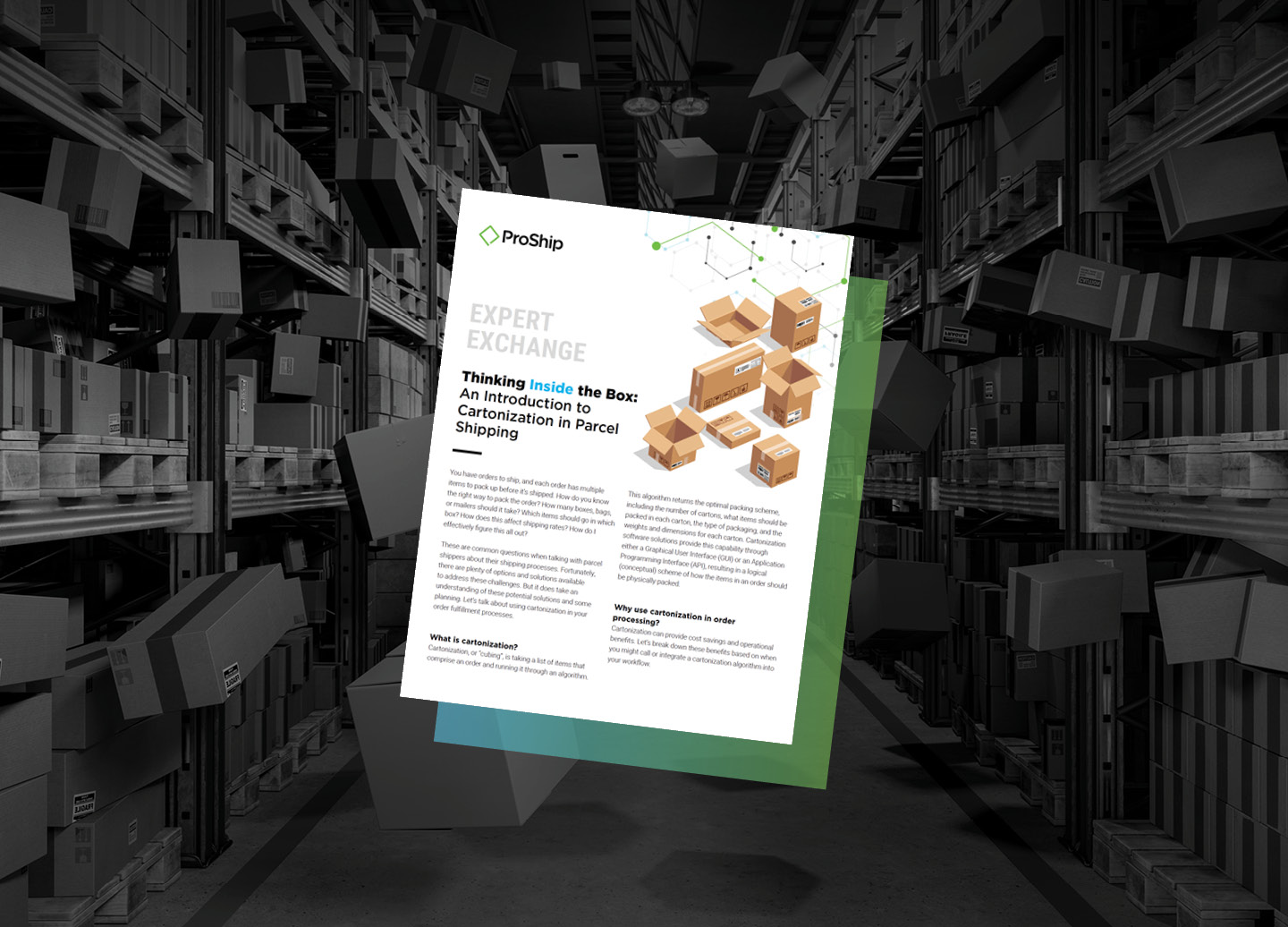[Expert Exchange] Thinking Inside the Box: An Introduction to Cartonization in Parcel Shipping

Discover how cartonization can provide cost savings and operational benefits
You have orders to ship, and each order has multiple items to pack up before it’s shipped. How do you know the right way to pack the order? How many boxes, bags, or mailers should it take? Which items should go in which box? How does this affect shipping rates? How do I effectively figure this all out?
These are common questions when talking with parcel shippers about their shipping processes. Fortunately, there are plenty of options and solutions available to address these challenges. But it does take an understanding of these potential solutions and some planning. Let’s talk about using cartonization in your order fulfillment processes.
What is Cartonization?
Cartonization, or “cubing”, is taking a list of items that comprise an order and running it through an algorithm. This algorithm returns the optimal packing scheme, including the number of cartons, what items should be packed in each carton, the type of packaging, and the weights and dimensions for each carton. Cartonization software solutions provide this capability through either a Graphical User Interface (GUI) or an Application Programming Interface (API), resulting in a logical (conceptual) scheme of how the items in an order should be physically packed.
Why Use Cartonization in Order Processing?
Cartonization can provide cost savings and operational benefits. Let’s break down these benefits based on when you might call or integrate a cartonization algorithm into your workflow.
You can receive some unique benefits by using cartonization upstream of the point where you print the shipping label, such as at order entry or wave release:
Accurate Rate Quotes
If you are quoting shipping rates to consumers at order capture time, e.g., in the shopping cart experience, determining how an order will be packed will allow your shipment rating software solution to provide a more accurate rate quote to the shopper. Note: This usage of cartonization often implies you need to quote the actual shipping rate to the shopper, and not just a proxy shipping cost such as a flat rate.
Packing Instructions
Knowing how an order should be packed before it is even picked in the warehouse allows you to provide precise packing instructions to warehouse staff when it’s time to box up the order, enhancing downstream processing efficiency. James Malley, Co-Founder and CEO at Paccurate, shares, "Quite a bit of untapped space exists within the majority of parcel shipments, even if they appear well-packed--between 50% and as high as 64% of empty space. A sophisticated cartonization solution can empower the warehouse staff to maximize the use of this space, without slowing them down."
Determine Mode of Transport
Understanding whether a shipment is most effectively packaged via parcels or pallets enables you to release the order to the right area of the warehouse for shipment preparation. Yes, cartonization works for freight shipments, too!
Benefits derived from cartonization regardless of when you use it include:
Reduce Shipping Costs
Identify the right packing configuration to reduce the number of cartons used and package dimensions, both of which impact the shipping rate. Combine cartonization algorithm results with a shipment software rating solution to evaluate packing configurations for the one that carries the lowest transportation cost.
Reduce Packaging, Increasing Sustainability Practices
Minimize the wasteful overuse of packaging materials and eliminate shipping empty space by finding the most efficient packing configuration for every order.
Where Does Cartonization Happen?
Cartonization utilizes optimization algorithms built on complex AI models. It can be offered as a feature of larger supply chain systems, like a Warehouse Management System (WMS). Additionally, there are specialized vendors in the market whose core competency is providing best-in-breed cartonization solutions. [Want to learn more about these industry-leading cartonization solutions? Reach out to the experts at Paccurate!]
How Can You Incorporate Cartonization into the Shipping Process?
It may make sense to inject cartonization routines upstream or downstream in the order fulfillment process.
- Using cartonization upstream: Consider calling a cartonization API from your E-commerce or Order Management System (OMS). When you use cartonization in these upstream processes, the solution will need a way to convey the selected packing configuration for orders to the person physically packing, whether through an API call, displaying it in a GUI, or printing a packing schedule. Any of these can be used in conjunction with the workflow in an advanced multi-carrier shipping system as well.
- Using cartonization downstream: In a WMS or shipping software workflow, automated decision-making via a cartonization API is possible. Alternatively, a cartonization solution can provide directed packing to the user via a GUI.
Logically cartonizing orders in the fulfillment process can add both efficiency to your distribution process and a better experience for your customers. Combined with leading multi-carrier shipping software, you can improve your operations by thinking both inside and outside the box!
Looking for more expert insights on all things shipping? Check out our library of Expert Articles.

Go beyond the box with ProShip Software
Partnering with the right expertise who understands effective technology solutions and planning will help your business efficiently manage shipping challenges. Are you interested in cost savings and significant benefits when it comes to your shipping operations? Contact one of our shipping experts or schedule a discovery call to learn how ProShip can transform the way you ship.
About the Author
Clint Boaz is Senior Sales Engineer for ProShip Multi-Carrier Shipping Software, where he leverages his expertise to show shippers how integrated multi-carrier shipping solutions can bring efficiencies to their business. Prior to joining ProShip, Clint held various roles at UPS. Clint lives in Tulsa, Oklahoma with his wife and three children.
